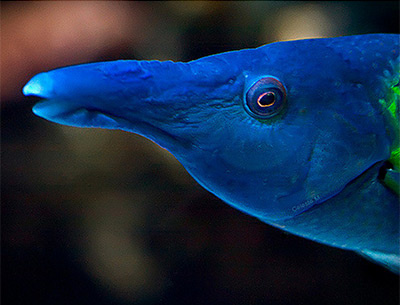Most marine aquarium hobbyists keep a close eye on their fish for certain tell-tale signs of ill health. And that’s a good thing, since quick intervention in the case of fish disease can often be the difference between life and death for the specimen(s). On the other hand, we do need to be cautious about overreacting to every suspicious visual or behavioral symptom because sometimes these warning signs may not be what they seem.
Remember, if misapplied, medications and therapeutic protocols for fish can do considerably more harm than good. It’s important to have a fairly high degree of confidence in your diagnosis before proceeding with treatment. That means you have to guard against misinterpreting normal behaviors or forgetting that more than one problem can cause similar symptoms.
To help illustrate this point, here’s a sampling of symptoms that may or may not spell trouble for your fish depending on the context:
Flashing
If you’ve ever been through a major outbreak of Cryptocaryon irritans, no doubt the sight of a fish turning on its side and scraping its body on the rockwork causes your heart to skip a beat. And, indeed, flashing is a potentially worrisome symptom. However, this behavior doesn’t automatically signal the presence of a parasite or other problem. From time to time, many perfectly healthy fish will exhibit this behavior—what I can only assume to be the fishy equivalent of scratching an itch (though not necessarily scratching ich).
From my experience, this behavior is somewhat common among various wrasse species. The first time I noted it was in a bird wrasse (Gomphosus varius), and it nearly made my head explode because the specimen had been properly quarantined for a month and never showed any sign of disease. Fortunately, the behavior never intensified and the fish appeared pretty healthy and calm otherwise. I decided to simply observe the specimen, which turned out to be the proper course because no disease ever materialized.
Pitting on the head
Pitting or tissue loss on the face and head of a fish can be a sign that head and lateral line erosion (HLLE) is developing. But such isn’t always the case. Sometimes this symptom is merely a mechanical injury that will heal in short order if the specimen is provided proper water conditions. Other times, it can be a natural characteristic of the species.
For instance, the Pacific blue tang, aka the regal tang or palette surgeonfish (Paracanthurus hepatus), naturally develops freckle-like markings on its face as it ages, and these can easily be mistaken for the start of HLLE. Of course, there is a complicating factor to consider here: Captive specimens of P. hepatus also happen to be highly susceptible to HLLE, so you have to observe them carefully and try your best to discern between those natural markings and the start of something more sinister.
White spots or “growths”
Sometimes white spots or lumpy growths that suggest a disease such as ich or lymphocystis are actually caused by excessive mucus production—with the mucus either trapping bits of debris or forming clumps that cling to the fish’s body or fins.
In this circumstance, there’s still likely a problem to deal with because, unless the fish just happens to be a naturally slimy species, something is causing the excessive mucus production to begin with. Of course, various diseases can cause this symptom, but so can a wide range of water-quality issues. Obviously, treating for disease when the problem is out-of-whack water parameters won’t do your fish any good.
“Net damage”
Many years back, I purchased a small group of green chromis (Chromis viridis) only to have them die one after another in quarantine. The dead specimens exhibited a linear bruise across the body posterior to the dorsal fin that looked suspiciously like net damage. Aha, I thought to myself, these must have succumbed to rough handling inflicted at some point in the supply chain. But with the benefit of having read and edited Jay Hemdal’s The Salt Smart Guide to Preventing, Diagnosing, and Treating Disease of Marine Fishes, I can now be fairly confident those “bruises” on the chromis had nothing to do with being netted. Instead, they were likely one of the characteristic symptoms of red-band syndrome, caused by the protozoan Uronema marinum.
In the section of the book dedicated to red-band syndrome, Hemdal writes, “Almost universally, aquarists who do not have access to a microscope will identify this disease as a ‘secondary bacterial infection resulting from some injury.’ In fact, ‘capture damage’ is often cited as the original cause due to the often linear nature of the lesion, which looks much like a bruise from being hit with a net frame, for example. The rapid onset of the lesion (often many days after capture) and the fact that it develops internally and then erupts externally both point to another cause.”
A fish lying on its side
It would seem to be a safe bet that a fish lying flat on its side is in pretty bad shape—either on its last legs (fins?) or already “checked out.” But sometimes a fish in this orientation is still alive and well but “playing possum” for some reason.
I’ve seen this in various triggerfishes, usually when they’re newly introduced to a system or when their tank contains minimal rockwork. Perhaps this behavior is a stress response or an effort to keep a low profile when they can’t wedge themselves into rockwork crevices as they would in nature. But whatever the motivation, it can be hair-raising waiting to see if the specimen will eventually come around.
What’s the takeaway?
My point in all this is not to downplay worrisome symptoms or discourage hobbyists from responding in a timely manner to fish disease. Rather, I’m merely emphasizing that taking the right course of action—assuming any action is even necessary—is just as important as initiating prompt treatment. And that depends on making the best possible diagnosis based on all the available facts.



